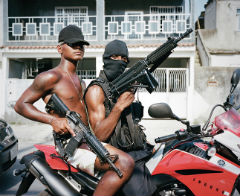Weapons seizure figures from Brazil suggest Rio de Janeiro’s criminals are seeking out ever more powerful guns, underlining the reasons behind the city’s launch of a new anti-arms trafficking intelligence unit.
Weapons listed as “category A,” such as rifles, machineguns and sub-machine guns, accounted for nearly 40 percent of weapons seized in Rio 2013, representing a 33 percent increase since 2009, reported Estadao.
With 8,101 weapons seized, 2013 also reversed the trend of falling arms seizures, which rose for the first time since 2009.
The head of Rio’s Civil Police, Fernando Veloso, said 47 percent of the arms seized originated in the United States, with many of them passing through Paraguay before being smuggled to Brazil, according to Estadao.
Another main source is the arsenals of security forces, a fact reinforced by the disappearance of 26 weapons, including 11 rifles, three machineguns and three shotguns from a Rio Military Police cache last month.
The new figures on arms seizures, released by the state Public Security Institute (ISP), follow a declaration by Rio Security Secretary Jose Mariano Beltrame that the state’s Department of Security is to create a new intelligence center to monitor arms trafficking in Rio.
The unit, which will begin work in June, will bring together military, civil and federal police to improve surveillance of Rio’s state borders, reported Estadao.
InSight Crime Analysis
Around 90 percent of murders carried out in Brazil involve firearms, and according to the Small Arms Survey there are up to 9.6 million illegal weapons in the country.
The gangs that run many of the Rio’s slums, or favelas, have long shown a preference for high-powered arms. Such weapons can be highly destructive in these dense urban environments, and the police say the use of these arms has contributed to the controversial militarization of their operations as they fight fire with fire.
SEE ALSO: Brazil News and Profiles
However, Rio state saw a dramatic 44 percent drop in gun deaths between 2000 and 2010, according to a report by non-governmental organization the Brazilian Centre for Latin American Studies (Cebela), and murder rates in the city, if not the state, have continued a downward trend since then. This has largely been attributed to the Slum Pacification Program (UPP), which has seen specialist police units occupy troubled favelas.
Nevertheless, over the last year there have been growing signs of a resurgence of gang activity in several UPP occupied favelas, and the rise in seizures of high-powered weapons is a reminder that Rio’s organized crime networks remain a significant threat to the city and state’s security.

